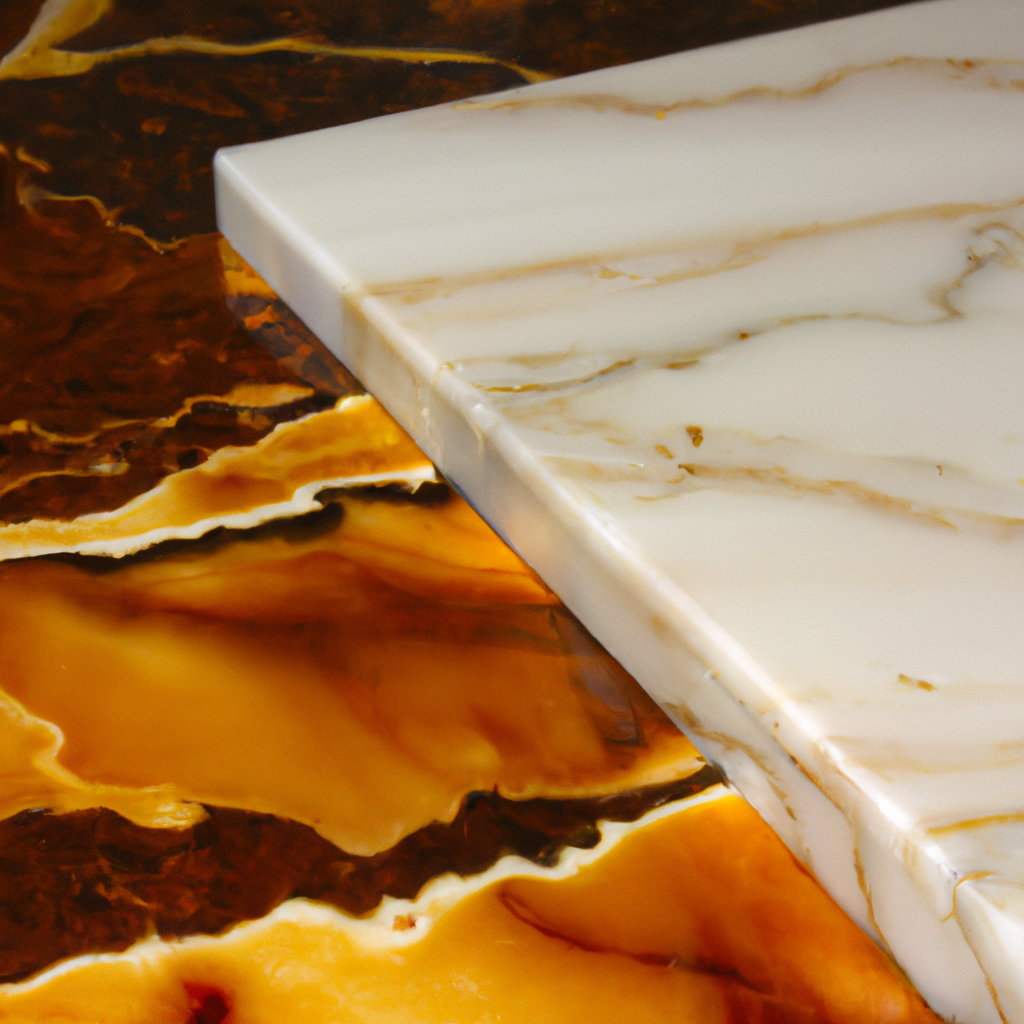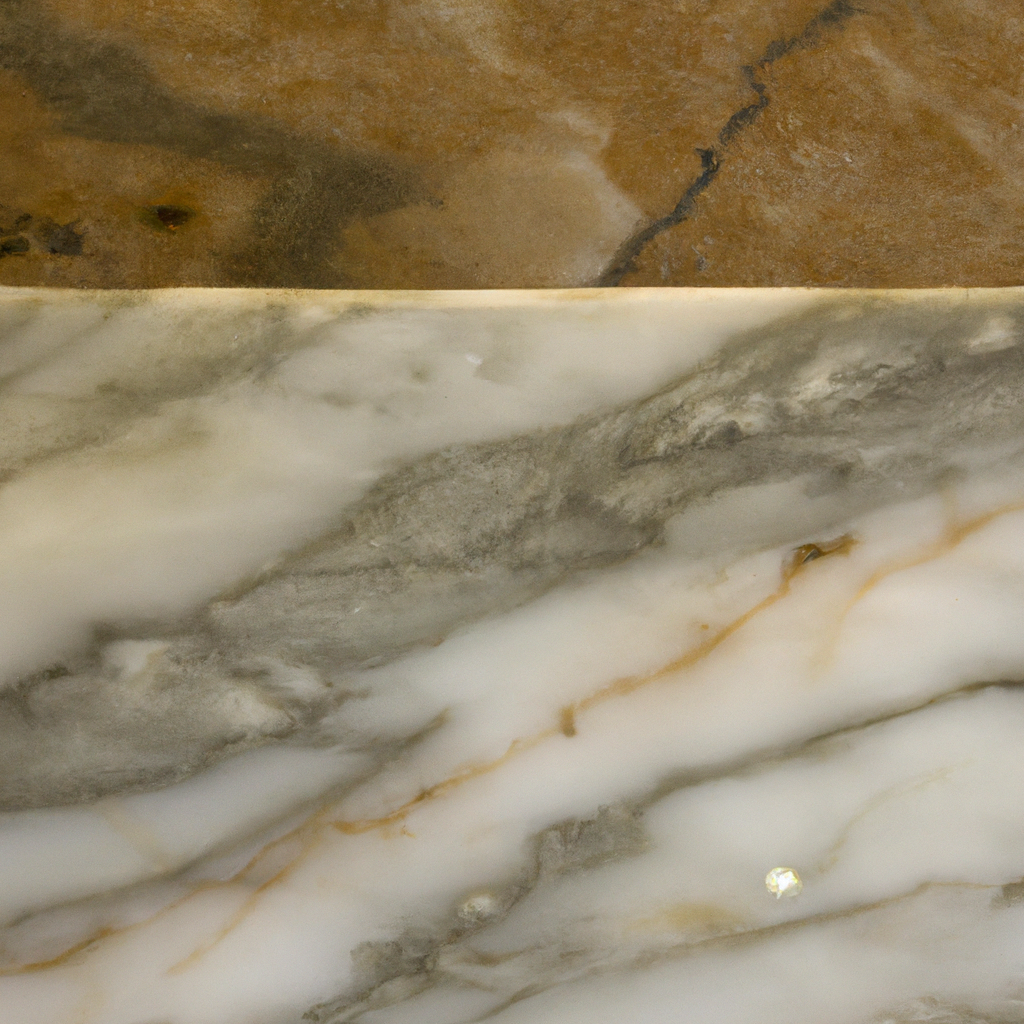Key Takeaway:
- Both quartzite and marble countertops are considered high-end options. However, quartzite is generally more expensive due to its durability, hardness, and resistance to heat and scratches. Marble, on the other hand, is more prone to damage and requires regular maintenance.
- The appearance of quartzite and marble countertops can vary, but both offer stunning natural patterns and colors that add a luxurious touch to any space. Marble tends to have a softer, more elegant look, while quartzite has a more modern, dramatic appearance.
- When choosing between quartzite and marble countertops, it’s important to consider your lifestyle and personal preferences. If you prioritize durability and low-maintenance, quartzite may be the better option. If you value the unique beauty and character of natural stone and don’t mind a bit of upkeep, marble could be the way to go.
Fancy a lavish, high-end look for your countertops? Quartzite or marble – make your pick for the perfect statement! Let’s compare these two options and see which one is more opulent.
Introduction
In the competitive world of countertop materials, quartzite and marble have always been at the forefront of high-end choices. But which of these two luxury materials truly reigns supreme? In this section of the article, we’ll start by defining quartzite and marble countertops, highlighting their unique characteristics and differences. From there, we’ll lay out the purpose of the article and clarify the search intent behind delving into the comparison between these two materials. By the end, you’ll have a clearer idea of what to expect in the following sections and the knowledge you need to determine which countertop is truly more high-end.
Definition of Quartzite and Marble Countertops
Quartzite and marble countertops are highly sought-after, by homeowners, architects, and interior designers. They are luxurious materials, with unique features that make them stand out from other options!
Quartzite is a type of metamorphic rock, known for its hardness, roughness, and abrasiveness. It’s quarried mainly in India, Brazil, and other locations. As it’s time-consuming to quarry, quartzite is relatively scarce. This scarcity makes it higher value and costlier, with prices ranging from mid to higher.
Marble is softer, mainly composed of calcite. It has varying colors and patterns, depending on impurities in the limestone. Prestigious varieties, like Carrara, Statuario, and Calacatta, have unique veining and patterns. Marble is cheaper than quartzite, with pricing starting in the lower range for more common varieties.
Durability is a key consideration. Generally, quartzite is harder and more scratch-resistant than marble, especially soft quartzite. But, honed or leather finishes can help maintain their appearance, as acidic substances can etch their surface.
The choice between quartzite and marble countertops comes down to personal preference and budget. Work with reputable dealers who offer both materials, with expert advice and edge treatments. Quartzite slabs are usually larger, allowing for bigger seamless applications. Both materials will add luxury and elegance to your home!
Purpose of the Article and Search Intent
This article educates readers about the differences between quartzite and marble countertops. Both are popular due to their durability, unique patterns, and high-end look. Quartzite is known for its strength and resistance to scratches and etches, while marble is softer and more porous.
Quartzite falls in the mid to higher price range. But, scarcity of the material can affect the cost. It’s a fragmented type of stone that’s time-consuming and requires special equipment to cut and shape. Thus, it’s usually pricier than granite and sandstone.
Proper care is crucial for natural stone countertops. Home- and business-owners should consult specialists and request an online contact form for queries.
Durability, maintenance, and aesthetics must be considered when choosing quartzite and marble countertops for residential and commercial purposes.

Comparison of Quartzite and Marble Countertops
When it comes to choosing the right countertop material for your kitchen or bathroom, there are a lot of factors to consider. Quartzite and marble are two popular options, but which one is more high-end? In this section, we’ll compare the pros and cons of quartzite vs. marble countertops.
Cost Comparison
First, we’ll look at the cost comparison between these two materials.
Durability
Then, we’ll examine how they stack up in terms of durability.
Maintenance and Care
Finally, we’ll discuss the differences in maintenance and care required for each material.
By the end of this section, you’ll have a better understanding of which option is best for your needs.
Cost Comparison
Comparing the cost of quartzite and marble countertops? There are a few factors to consider. Quartzite is natural quartz sandstone, quarried and cut into slabs. Marble is metamorphic rock, made of limestone or dolomite, subjected to heat and pressure. Both are durable and scratch-resistant, though marble can etch from acid spills.
Quartzite is generally pricier due to limits in quarrying and high demand. Marble falls into mid to higher ranges, depending on type. The most prestigious – Carrara, Statuario, and Calacatta – are costlier. Whereas Bianco Romano and Taj Mahal are budget-friendly.
When selecting, think about how the countertop will be used. Marble is great for residential applications (kitchen remodel). Quartzite is more durable and lower-maintenance, good for residential and commercial. Check honed finish and scratch resistance with Mohs Hardness Picks.
It’s a personal choice – preference, budget, and purpose. Homeowners can make an informed decision when selecting their ideal countertop material.
Durability Comparison
Comparing durability and performance of two countertop materials? Quartzite and marble take center stage. Both are natural and used for residential and commercial applications, yet there are differences.
Quartzite is a mined metamorphic rock while marble is made from limestone that has been heat and pressure transformed. Quartzite is scarce and hard to source, making it more expensive and time-consuming. It’s durable and abrasion resistant due to diamond blades, wires and polishing heads used in manufacturing.
Marble countertops are less expensive, coming in a wide range of varieties such as Carrara, Statuario and Calacatta. Both quartzite and marble require sealing to maintain stain resistance. Vinegar etches marble, but quartzite is resistant to acidic substances. Quartzite countertops can handle scratch tests better, making them suitable for busy kitchens.
Price often plays a role in choosing the right material, with quartzite in the higher price range. Marble may be preferred for budget-minded homeowners, while quartzite is chosen for luxury. Both remain popular for showroom availability and wide selection for commercial applications.
Maintenance and Care Comparison
When it comes to selecting a natural material for your kitchen, quartzite and marble are two popular choices. They are both metamorphic rocks from different parts of the world. Quartzite is formed from sandstone and quartz under heat and pressure. Marble is created when it’s exposed to high temperatures and pressure.
Quartzite is known for its durability and heat-resistance. Marble is softer and porous, making it more prone to scratches, etching, and staining. Quartzite needs less upkeep compared to marble. But quartzite is limited in availability. Marble has a wider selection of colors and patterns.
Their price points also differ. Quartzite is in the higher price range due to its strength and time-consuming processing. Marble is usually in the lower range, but luxury types like Carrara, Statuario, and Calacatta marbles can be pricier.
The manufacturing process also affects care and maintenance needs. Quartzite is a natural stone and doesn’t need resins or pigments. Marble, being softer, often requires resins for reinforcement. Diamond tooling and an abrasive stone are used to polish both quartzite and marble.
So, when choosing between quartzite and marble, it’s important to consider their maintenance and care. Marble is prestigious, but quartzite is becoming a luxury natural stone for countertops and backsplashes.

Choosing Between Quartzite and Marble Countertops
Selecting the perfect countertop for your home can be a daunting task, especially with so many options on the market. Two popular choices to consider are quartzite and marble countertops. In this section, we will discuss the process of choosing between quartzite and marble countertops, and we’ll explore important factors to consider when making this decision. The two sub-sections in this article will lead us through a comprehensive guide on how to choose the perfect countertop based on your lifestyle, needs and design preferences.


Consider Your Lifestyle and Needs
Choosing between quartzite & marble countertops for your kitchen remodel? Consider your lifestyle & needs. Both offer a range of colors and patterns, but they differ.
Marble is a classic, luxurious look. But it’s softer & more porous. Scratching, etching & staining are possible unless sealed regularly.
Quartzite is hard & durable. It’s similar to marble in beauty, but with better wear & tear resistance. It’s pricier, due to scarcity.
Carrara Marble & Quartzite have a difference in price per square foot of countertop. Marble is $55-$65. Quartzite is $70-$120.
Conclusion: If you want a high-end, prestigious stone & don’t mind upkeep, marble is great. If you want a durable, low-maintenance option & can invest more, quartzite is best.
Consider Your Design Preferences
Choosing between quartzite and marble countertops can be difficult. Both are luxurious and durable, so they’re a popular choice for homeowners. But there are differences in their design.
- Quartzite is a natural stone, harder than marble. This makes it less likely to chip, scratch, or etch – great for kitchen remodeling.
- Marble is known for its white background and grey veins – a timeless classic.
Price is a major difference. Marble is more expensive than quartzite, which takes longer and more resources to quarry. Quartzite is rare, so quarries have limitations that make it time-consuming.
If you want a more affordable option, quartz countertops are a manufactured material with a lower price range.
When choosing, consider your needs, design, and budget. Evaluate other materials, like granite or soapstone, to see if they meet your criteria. Think about your lifestyle and habits too. This will help you decide how much maintenance is needed. In the end, it’s a matter of preference, design style, and budget.
Pros and Cons of Quartzite Countertops
For those in the market for a luxurious and high-end countertop, quartzite and marble are among the top contenders. In this section, we will examine the pros and cons of quartzite countertops so that you can make an informed decision when selecting the best material for your kitchen or bathroom renovation. We will explore both the advantages and disadvantages of quartzite countertops, giving you a comprehensive understanding of this popular natural stone material.
Advantages of Quartzite Countertops
Quartzite countertops are popular with homeowners for their unique features and benefits. Here are some pros and cons to consider when deciding on countertop surfaces:
Durability: Quartzite is strong and long-lasting, able to withstand high temperatures, scratches, and stains. It can stay polished for years, making it great for kitchens and bathrooms.
Aesthetics: Quartzite is elegant and comes in many colors and patterns. Statuario marble, a type of quartzite, is known for its white/grey background and grey veins.
Low Maintenance: Non-porous and bacteria-resistant, quartzite is perfect for those who want a stone countertop without the hassle.
Price Differences: Quartzite is usually more expensive than other natural materials due to its complex quarrying process and limited supply. Nevertheless, it’s only moderately pricier than marble.
Suitable for all surfaces: Quartzite works well in all places that need an elegant and durable countertop – from kitchens to bathrooms, offices and beyond.
Quartzite has great benefits, but remember the restricted quarrying and supply. Homeowners may find the selection process difficult due to its rarity. Still, quartzite is more durable and requires less upkeep than marble.
Disadvantages of Quartzite Countertops
Quartzite countertops have their disadvantages. Unlike granite or marble, they are not as widely available. Quarrying quartzite is slow and requires specialist tools, meaning supplies can be scarce and prices high. Furthermore, quartzite counters must be sealed regularly to avoid staining or harm from acidic substances. This is a tedious job.
According to industry data, quartzite makes up less than 5% of all countertop materials used for kitchen and bathroom applications in the United States.
Marble countertops are a more prestigious material, with unique patterns and veining. Quartzite can’t compete in terms of style, but it is less likely to chip or scratch, making it more durable.
Studies show that marble is more susceptible to surface damage than quartzite. Marble’s density ranges from 2.5-2.7 g/cm3, while Quartzite’s density ranges from 2.65-2.85 g/cm3, making it less porous than marble and less likely to chip or etch over time.
Ultimately, the decision between quartzite and marble depends on budget and personal taste.
Pros and Cons of Marble Countertops
Marble countertops are a popular choice in both residential and commercial properties, but like any material, they have both pros and cons. In this section, we will take a closer look at the advantages and disadvantages of marble countertops to help you make an informed decision about whether they are the right choice for your space. We’ll explore the many benefits of marble countertops, from their striking appearance to their heat-resistance properties, as well as their drawbacks, including their susceptibility to scratches and staining. By the end of this section, you’ll have a clear understanding of whether marble countertops are the best fit for your needs.

Advantages of Marble Countertops
Marble countertops offer many benefits for homeowners who want strength and a unique look. They don’t get too hot, making them great for cooking areas. Plus, they just need regular cleaning to keep looking good. Marble countertops also have a timeless elegance and status that can boost the value of a home and add sophistication to its design.
Interestingly, Quartzite countertops may be more expensive than Marble because it’s harder to find. Quarrying Quartzite takes a long time, and there are limits on how much can be taken.
Marble counters have pros and cons. Finding high-quality marble can be hard, which drives up installation costs. It also stains and scratches easily, which may not be ideal for some people.
It’s important to compare the advantages and disadvantages of marble and quartzite countertops before making a decision. If you desire a natural stone with prestige, the special benefits of marble countertops make them an excellent choice.
Disadvantages of Marble Countertops
Marble countertops might look classy and elegant in your kitchen, but there are some drawbacks. Quartzite is a rarer, tougher option. Plus, getting marble can be costly and take time.
When deciding between marble and quartzite countertops, think about their pros and cons. Marble adds beauty and value to a home, while quartzite is less porous and needs less care. But quartzite may be pricier and harder to find.
It boils down to your personal preferences and needs. If you want a stylish countertop, marble may be right. But if you want something tough and long-lasting, quartzite might be better.
Do your research before upgrading your home.
Maintenance and Care for Quartzite or Marble Countertops
Maintenance and care are crucial for any high-end countertop investment, and quartzite and marble are no exception. In this section, we will examine the key differences in cleaning, preventing damage, and sealing between quartzite and marble countertops. We will provide cleaning tips to ensure your countertops maintain their polished look and durability. Additionally, we’ll investigate precautions you can take to prevent damage to your high-end investment. Finally, we will explore the necessity and best options for sealing your countertops to protect them from wear and tear.

Image credits: kitcheninfinity.com by Hillary Washington
Cleaning Tips
Maintaining and caring for high-end marble or quartzite countertops is important for their longevity. Here are some tips to keep them looking their best:
- Wipe away spills or stains immediately with a damp cloth or sponge. Avoid acidic or abrasive cleaners.
- For stubborn stains, use mild dish soap and warm water. Don’t use too much pressure.
- Dry completely with a soft, clean cloth to prevent water spots/streaks.
- Consider a sealant to protect from damage, such as stains, scratches, etc.
When deciding between marble and quartzite, there are differences. Quartzite is unique and durable, but hard to find. Marble is classic, but needs more maintenance. The choice depends on personal preferences and lifestyle.
Preventing Damage
Marble and quartzite countertops are both beautiful home additions. They need regular maintenance to stay in good condition, though. Both are known for their durability and attractiveness. Quartzite is rare, though. It needs special attention due to its scarcity and hard-to-extract process. Plus, it’s usually pricier than marble.
To keep your quartzite or marble countertops perfect:
- Clean spills right away to stop stains.
- Use a soft sponge or cloth with mild soap and water for daily cleaning.
- Avoid acidic or abrasive cleaners. They can scratch the countertop surface.
- Seal your countertops regularly to prevent moisture from getting in.
- Use heat-resistant pads or trivets to protect from hot pots and pans.
In the end, it’s up to you whether you choose marble or quartzite. Marble is known for its timeless look, while quartzite offers a more natural feel. Whatever you decide, taking proper care of your countertops will keep their looks and function for a long time.
Sealing Your Countertops
Sealing your countertops is key for protecting them from stains, scratches, and other damages. To do this:
- Clean them with soap and warm water. Let them dry completely.
- Apply a penetrating sealant, covering them evenly. Leave it for 10 minutes then wipe away any excess.
- Wait for 24 hours for the sealant to dry.
- Repeat this process every 1-2 years.
Marble and quartzite are both great countertop options, but they differ. Marble is luxurious and high-end, featuring unique veins and patterns. Quartzite is durable, has unique patterns, and has a glossy finish. However, it is more expensive and time-consuming to get quartzite due to its scarcity.
Keep your countertops in perfect condition! Use cutting boards and trivets when placing hot materials on them to avoid burns or scratches.
Conclusion: Which Countertop Material is Right for You?
Marble or quartzite countertops? It depends on your needs and wants. They’re both natural stone materials, but they have differences in composition, look, and strength.
Marble or Quartzite? – Marble is a metamorphic rock made of re-formed minerals. Quartzite is a hard, metamorphic rock, once a type of sandstone. Marble has bold, dramatic veins. Quartzite’s veins are more subtle and linear.
Scarcity of Quartzite – Quartzite is not as common as other natural stone materials, like granite or marble. Plus, it takes time to make, so it’s more costly.
In sum, if you want durability and don’t mind paying more, quartzite is great. If appearance is your priority and you’re okay with regular maintenance, pick marble.
Five Facts About Quartzite vs. Marble Countertops:
- ✅ Quartzite is a harder and more durable natural stone than marble, making it more resistant to scratches and etching. (Source: MS International)
- ✅ Quartzite has a more natural look with unique patterns and textures, while marble has a classic, elegant look with veining. (Source: Polycor)
- ✅ Marble is more porous than quartzite, making it more susceptible to stains and discoloration. (Source: MSI Surfaces)
- ✅ Quartzite is heat-resistant and can withstand hot pots and pans without burning or scorching, while marble is more likely to be damaged by heat. (Source: HGTV)
- ✅ Quartzite is generally more expensive than marble due to its durability and unique patterns, making it a more high-end option for countertops. (Source: Countertop Investigator)
FAQs about Quartzite Vs. Marble Countertops: Which Is More High-End?
What is the difference between Quartzite and Marble countertops?
The difference between Marble and Quartzite is that they are both natural stones, however, they have unique qualities. Whereas marble is a metamorphic rock made from limestone, quartzite is a metamorphic rock made from sandstone. Compared to marble, quartzite is much tougher, more resilient, and less prone to scratches and stains. In contrast, marble is more porous and softer, which makes it more vulnerable to stains and etching.
Which is more high-end, Marble or Quartzite?
Marble and Quartzite are prestigious natural stones that are considered high-end materials for countertops. The choice between the two ultimately depends on personal preferences in terms of aesthetics and usage. Quartzite is a more practical choice for high traffic areas, while Marble is a more luxury option.
Why is Quartzite more durable than Marble?
The Quartzite is more durable that Marble since it is formed under high pressure levels and temperatures, which transforms the sandstone into a hard and durable stone with low porosity. Marble, on the other hand, is composed of calcium carbonate, which makes it softer and more prone to staining and etching.
Are there any quarrying limitations to getting either Marble or Quartzite countertops?
Yes, there quarrying limitations to getting either Marble or Quartzite countertops. For instance, some varieties of White Marble are more scarce because they are only present in specific regions of the globe. While being more accessible, quartzite can still have mining restrictions depending on where it was mined.
Is the installation process for Marble and Quartzite countertops time-consuming?
Yes, the installation process for Marble and Quartzite countertops can be time-consuming. The installation process typically involves measuring, cutting, and polishing the countertops to fit the desired space, which can take several hours or even days depending on the size and complexity of the project.
Which is more expensive, Marble or Quartzite countertops?
Quartzite countertops are typically more expensive than those made of marble. Depending on the stone’s quality, source, and availability, the cost of the two components may change.



